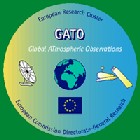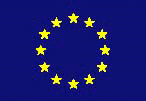QUILT Home
Project login

GATO cluster
Brochure
for A3-printer

Quantification and Interpretation of Long-Term UV-Vis Observations of the Stratosphere
This project is supported by the European Commission - DGXII Fifth Framework Programme on Energy, Environment and Sustainable Development
Acronym: |
QUILT |
|
Title: |
Quantification and Interpretation of Long-Term UV-Visible Observations of the Stratosphere | |
Contract Number: |
EVK2-2000-00545 | |
Project Duration: |
01.01.2001 - 30.06.2004 |
|
Keywords: |
Stratospheric Ozone, UV-Visible Remote Sensing, Satellite Validation, Montreal Protocol | |
Research Priority: |
Better Exploitation of Existing Data and Adaptation of Existing Observing Systems | |
Participants: |
Consortium at the bottom of the text |
Project Objectives:
This project addresses RTD key action 2, in particular 2.1.2, stratospheric ozone depletion, 2.4.1, better exploitation of existing data, and 2.4.2, development of new long-term observing capacity. The general aim is to use the existing ground-based, satellite and balloon borne UV-visible data as well as 3D atmospheric modelling tools for quantifying ozone loss in the past, to monitor its development in the present and to investigate its relation to active halogen and nitrogen species. The project includes four main specific objectives:
1. To create a homogeneous, quality controlled data set out of the existing O3, NO2, BrO, and OClO data from ground-based zenith-sky, balloon and GOME satellite measurements.
2. To improve the analysis algorithms and thereby the quality of the derived columns and profiles.
3. To use the established data set for the validation and improvement of 3D atmospheric models and the study of seasonal variations and trends of ozone and related species in the stratosphere.
4. To provide Near Real Time (NRT) data and quality controlled long-term data to the scientific end-user community.
QUILT Deliverables
WP 2500: Radiative Transfer Interface
Read me file (Updated June 2005)
Links to QUILT Data Products
During the winter periods coinciding with this project, several data products will be made accessible to the scientific end-user community and the general public via this website. The data available from this website are PRELIMINARY data, and should not be cited in scientific publications without the consent of the corresponding principle investigator(s).
GOME NRT Data Products (Co-operation between the University of Bremen, University of Heidelberg and NILU. Logistical assistance from the Swedish Space Corporation (SSC) in Kiruna, Sweden, and the Deutsches Fernerkundungszentrum of the German Aerospace Centre (DLR-DFD) is greatly appreciated. Access to NRT GOME data was granted by the European Space Agency (ESA).
3D CTM Data Products-SLIMCAT (UNI-Leeds)
PV Forecasts-MIMOSA (CNRS-SA) (CNRS-SA)
Ground-Based SAOZ Station Reports (Weekly status reports from project stations located mainly in the Arctic)
Ground-Based DOAS Station Reports (Weekly status reports from project stations located mainly in the Arctic)
Balloon Profile Data Reports (Preliminary Balloon Profile Data from CNRS-SA and the University of Heidelberg)
Arctic Stratospheric Ozone Bulletins (Weekly status reports in co-operation with the World Meteorological Organization, WMO, Geneva, Switzerland)
Other Relevant Data Links
NASA Annual NCEP Data for the Northern Hemisphere
DLR Meteorological Analyses and Forecasts for the Arctic Stratosphere
Consortium:
| NILU | Norwegian Institute for Air Research, Kjeller, Norway |
| BIRA-IASB | Belgisch Instituut voor Ruimte-Aëronomie - Institut d'Aéronomie Spatiale de Belgique, Brussels, Belgium |
| UNI-BREMEN | Universität Bremen, Germany |
| CNRS-SA | Service d'Aéronomie du Centre National de la Recherche Scientifique, Paris, France |
| UNI-HEIDELBERG | Universität Heidelberg, Germany |
| UNI-LEEDS | University of Leeds, School of the Environment, United Kingdom |
| NERC-BAS | NERC-British Antarctic Survey, Cambridge, UK |
| INTA | Instituto Nacional de Tecnica Aerospacial, Torrejón de Ardoz, Spain |
| SRON | National Institute for Space Research, Utrecht, The Netherlands |
| CNR-ISAC | Institute of Atmospheric Sciences and Climate, Bologna, Italy |
| NIWA | National Institute of Water and Atmospheric Research, Lauder, New Zealand |
GATO-CLUSTER
QUILT is a part of the GATO (Global Atmospheric Observations) cluster of the European Commission. GATO is a cluster of five European Commission (EC) and a number of nationally funded projects which are furthering our understanding of the atmospheric chemistry processes which affect ozone depletion. The projects are in support of the Montreal and Kyoto Protocols. The main objective of the research in this cluster is to link together scientists involved in making atmospheric chemistry measurements to obtain accurate broad European or global coverage of ozone and related species. This work involves the use of existing data from ground based, balloon, aircraft and satellite measurements, including data from new field measurement campaigns. The GATO cluster will enable space agencies and atmospheric scientists working in this area to communicate effectively. The European Ozone Research Coordinating Unit works with the Research DG in the co-ordination of the GATO cluster. Further information concerning the GATO and other research clusters can be obtained from the European Ozone Research Coordinating Unit in Cambridge.
QUILT Coordinator |
Norwegian Institute for Air Research, Kjeller, Norway |
Responsible |
Dr. Geir Ole Braathen |
|
|
gob@nilu.no |
Telephone |
+47-63-89 8180 |
Facsimile |
+47-63-89 8050 |
EC scientific officer |
Riccardo.Casale@cec.eu.int |
Rita Larsen@nilu.no - Modified by Terje Krognes, NILU, 27 April 2004

